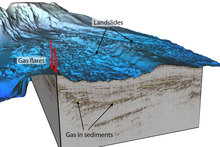May 12, 2014

A survey of the North Island’s East Coast has uncovered a huge hidden network of frozen methane and methane gas, along with dozens of spectacular flares firing up from the seabed
The vast deposit has been revealed by Kiwi and German scientists using state-of-the-art 3D seismic and echosounder technology to map methane within the ocean and seafloor.
NIWA marine geologist and voyage leader Dr Joshu Mountjoy said the number of gas flares observed beneath the ocean was “phenomenal”.
More than 100 flares, some shooting up columns more than 250m high, were found in an area of only 50km2, in what is now believed to be the densest concentration of seafloor gas vents so far known in New Zealand.
“What we’ve found probably equals the number of known underwater seeps in New Zealand to date,” Dr Mountjoy said.
Dr Mountjoy said the four-week expedition sought to understand what was triggering huge underwater landslides off the East Coast, some which had been as large as 15km long and 100m thick.
What they discovered was direct evidence of widespread gas in the sediment and ocean, and indications of large areas of methane hydrate, ice-like frozen methane below the seafloor.
They also found a hydrate and gas field very different from others known in New Zealand.
“Previously all gas venting sites have been in deeper water and associated with large earthquake faults,” Dr Mountjoy said.
“What we have found is high density methane flares in very shallow water, as well as gas building up beneath a large landslide and being released along the landslide margins.”
In a newly submitted scientific paper, the research team proposed that these landslides might be the seafloor equivalent of glaciers, but with frozen methane instead of water ice, or that pressurised gas was causing them to progressively move downslope.
The findings of the expedition indicated that both could be possibilities, but also gave an important insight into just how much methane lurked close to our shores.
Dr Mountjoy said methane was a highly effective greenhouse gas and seabed methane release has the potential to dramatically alter the earth’s climate.
As ocean temperatures changed, the methane hydrate system had the potential to become unstable.
“In terms of natural hazards, the occurrence of very large slow landslides, rather than catastrophic ones, has major implications for the tsunami generating potential of landslides globally as slow landslides are unlikely to cause tsunami,” he said.
“This type of slow moving submarine landslide is essentially unknown around the world, but it is very likely that they do occur widely and are an important process shaping continental margins.”
It was too early to say whether the methane deposits could prove an economic resource for the country.
Dr Mountjoy said the newfound gas were not coming from deep within the earth’s surface or connected to any large reservoirs with commercial potential.
But researchers in Japan were investigating how frozen methane could be converted back into a gas as a potential hydrocarbon resource.
The expedition forms the first part of a collaborative project between scientists from New Zealand, Germany, the United States and Malta, and another is planned for 2016.
